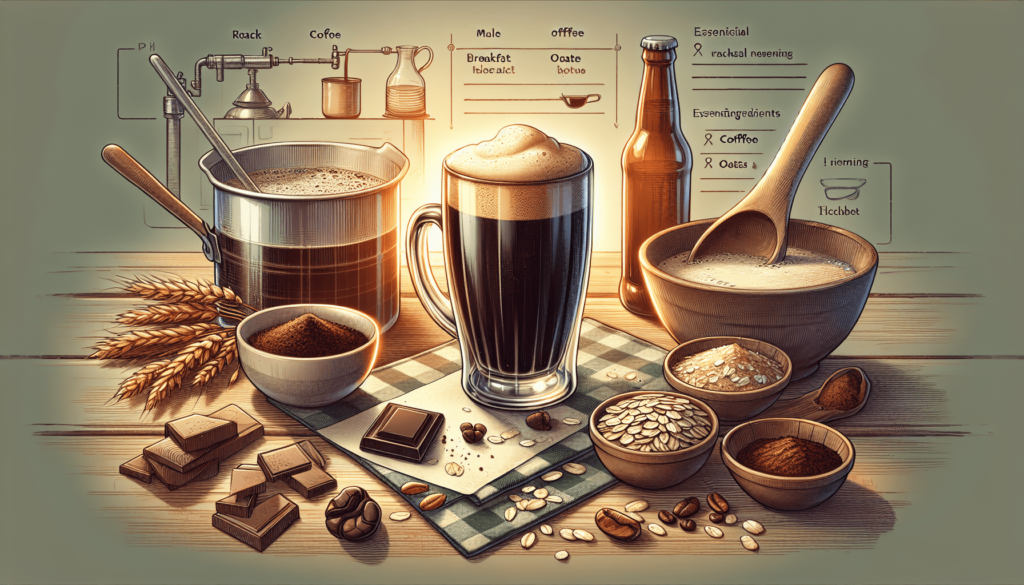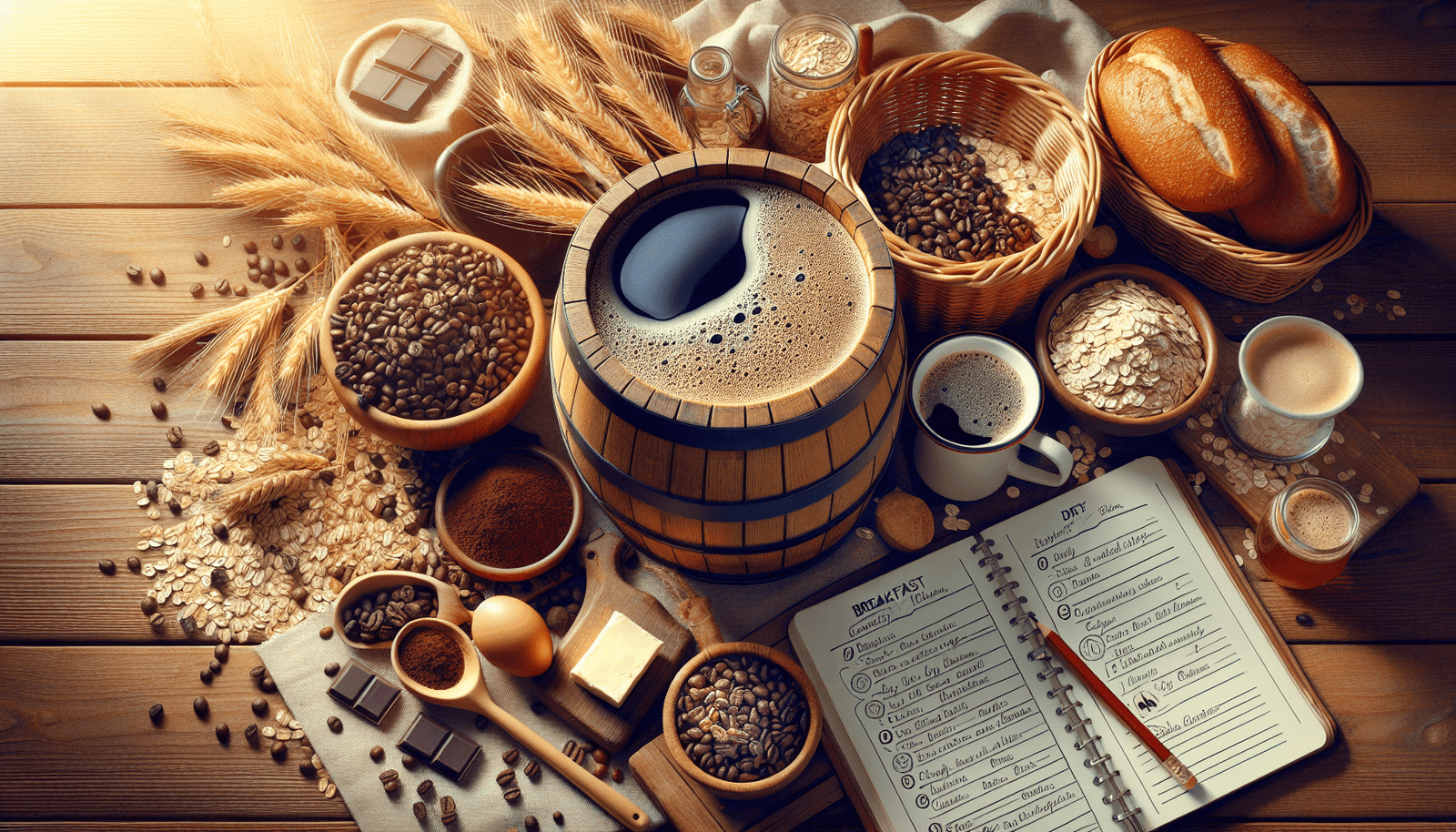Imagine waking up to the rich aroma of freshly brewed coffee and the sweet scent of chocolate wafting through your kitchen. You feel the excitement in the air as you prepare to embark on a culinary adventure – the creation of your very own breakfast stout! This article is your ultimate guide to crafting a delicious breakfast stout, packed with flavors of roasted malt, coffee, chocolate, and hints of sweetness. So grab your brewing equipment and get ready to transform your mornings with this irresistible brew.
Ingredients
Malts
The backbone of any good stout, malts provide the base flavors and colors for the beer. For a breakfast stout, opt for roasted malts like chocolate malt, black malt, and roasted barley, which will give your beer a rich, coffee-like flavor and a dark, chocolatey appearance.
Hops
While not as pronounced as the malts, hops add balance and bitterness to the beer. For a breakfast stout, choose hops with earthy or spicy characteristics that can complement the other flavors in the brew.
Yeast
Yeast is responsible for fermenting the sugars in the beer, converting them into alcohol and carbon dioxide. Select a yeast strain that can handle the higher alcohol content typical of stouts and can thrive in a dark, rich environment.
Coffee
To capture that breakfast feel, incorporating coffee into your stout is a must. Choose high-quality coffee beans that complement the flavors you want to highlight. Experiment with different roast levels and grind sizes to find the perfect balance of coffee flavor in your brew.
Chocolate
Chocolate adds a delightful, velvety smoothness to a stout. Opt for high-quality dark chocolate and melt it down before incorporating it into the beer. The chocolate should complement the other flavors without overpowering them.
Oats
The addition of oats not only adds body and creaminess to the stout but also enhances the smooth mouthfeel. Rolled oats are commonly used in stouts to achieve the desired texture and richness.
Molasses
Molasses adds a deep sweetness and complexity to the beer. Choose unsulfured molasses for its more robust flavor profile, which will further contribute to the overall depth and richness of the breakfast stout.
Brown Sugar
Dark brown sugar brings a subtle caramel flavor and sweetness to the beer, enhancing the overall complexity. Use it sparingly to avoid overpowering the other flavors in the stout.
Vanilla Extract
A touch of vanilla extract adds a smooth, aromatic note to the beer. It complements the coffee and chocolate flavors, providing a subtle sweetness and additional depth to the brew.
Bourbon
Bourbon adds a boozy kick and warmth to the breakfast stout. It imparts a rich, oaky character and enhances the complexity of the flavors. Use it in moderation to avoid overpowering the other ingredients.

Preparation
Mashing
To start brewing your breakfast stout, heat water to a specific temperature and add crushed malts. The temperature is crucial for extracting the desired flavors and enzymes from the malts. Maintain the temperature by periodically adding hot water or applying heat, and allow the malts to steep for the specified duration. After mashing, perform a mash-out by raising the temperature to deactivate enzymes and ensure optimal sugar extraction.
Boiling
Bring water to a boil in a large pot, then add hops according to the recipe instructions. Boil the mixture for the specified amount of time to extract the desired bitterness and flavor from the hops. This process also helps sanitize the wort and concentrate the flavors. During the boiling stage, additional flavorings such as spices or herbs can be added to enhance the complexity of the stout.
Adding Coffee
Select your favorite coffee beans and grind them to the desired coarseness. During brewing, add the ground coffee to the wort and stir gently to incorporate the flavors. The coffee should be added towards the end of the boiling process to prevent excessive bitterness or astringency.
Adding Chocolate
Choose high-quality chocolate and melt it down. Once melted, add the chocolate to the beer and stir gently to ensure it is thoroughly incorporated. The chocolate should be added after the brewing process to avoid exposing it to prolonged high temperatures, which could lead to undesirable flavors.
Adding Oats
During the boiling stage, add rolled oats to the wort and stir occasionally. The oats will contribute to the mouthfeel and add a creamy texture to the stout. They should be cooked alongside the other ingredients to allow their flavors to meld together.
Adding Molasses
Select unsulfured molasses for its fuller flavor profile, and add it to the boiling wort. Stir the mixture to ensure the molasses dissolves completely and evenly throughout the beer. The molasses will add a deep, sweet richness to the breakfast stout.
Adding Brown Sugar
Choose dark brown sugar, as it has more depth and complexity than lighter varieties. Add the brown sugar to the boiling wort and stir until fully dissolved. The brown sugar provides a subtle caramel note and enhances the overall sweetness of the stout.
Adding Vanilla Extract
For a hint of aromatic sweetness, add vanilla extract to the beer. Stir it gently to incorporate the vanilla flavor throughout the brew. Be careful not to add too much, as vanilla extract can overpower the other flavors if used excessively.
Adding Bourbon
To infuse your breakfast stout with a touch of boozy warmth, add bourbon to the beer. Its rich, oaky taste will complement the other flavors while providing a distinct character. Add the bourbon in moderation, as its strong flavor can easily overpower the other ingredients.
Fermentation and Aging
After the brewing process, transfer the beer to a fermentation vessel and pitch the appropriate yeast. Maintain a consistent temperature to encourage fermentation and monitor the progress closely. This stage allows the yeast to break down sugars, produce alcohol and carbon dioxide, and develop the desired flavors. Once fermentation is complete, the beer will benefit from conditioning and maturation, during which its flavors will continue to develop and meld together. Finally, bottle or keg the stout and allow it to age for optimal flavor and carbonation.
By following this comprehensive recipe, you can create a delicious, full-bodied breakfast stout packed with coffee, chocolate, and other complementary flavors. Enjoy the process of brewing your own beer and savor the satisfying results of your homemade breakfast stout. Cheers!



